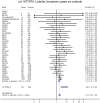Genetic predisposition to in situ and invasive lobular carcinoma of the breast
- PMID: 24743323
- PMCID: PMC3990493
- DOI: 10.1371/journal.pgen.1004285
Genetic predisposition to in situ and invasive lobular carcinoma of the breast
Abstract
Invasive lobular breast cancer (ILC) accounts for 10-15% of all invasive breast carcinomas. It is generally ER positive (ER+) and often associated with lobular carcinoma in situ (LCIS). Genome-wide association studies have identified more than 70 common polymorphisms that predispose to breast cancer, but these studies included predominantly ductal (IDC) carcinomas. To identify novel common polymorphisms that predispose to ILC and LCIS, we pooled data from 6,023 cases (5,622 ILC, 401 pure LCIS) and 34,271 controls from 36 studies genotyped using the iCOGS chip. Six novel SNPs most strongly associated with ILC/LCIS in the pooled analysis were genotyped in a further 516 lobular cases (482 ILC, 36 LCIS) and 1,467 controls. These analyses identified a lobular-specific SNP at 7q34 (rs11977670, OR (95%CI) for ILC = 1.13 (1.09-1.18), P = 6.0 × 10(-10); P-het for ILC vs IDC ER+ tumors = 1.8 × 10(-4)). Of the 75 known breast cancer polymorphisms that were genotyped, 56 were associated with ILC and 15 with LCIS at P<0.05. Two SNPs showed significantly stronger associations for ILC than LCIS (rs2981579/10q26/FGFR2, P-het = 0.04 and rs889312/5q11/MAP3K1, P-het = 0.03); and two showed stronger associations for LCIS than ILC (rs6678914/1q32/LGR6, P-het = 0.001 and rs1752911/6q14, P-het = 0.04). In addition, seven of the 75 known loci showed significant differences between ER+ tumors with IDC and ILC histology, three of these showing stronger associations for ILC (rs11249433/1p11, rs2981579/10q26/FGFR2 and rs10995190/10q21/ZNF365) and four associated only with IDC (5p12/rs10941679; rs2588809/14q24/RAD51L1, rs6472903/8q21 and rs1550623/2q31/CDCA7). In conclusion, we have identified one novel lobular breast cancer specific predisposition polymorphism at 7q34, and shown for the first time that common breast cancer polymorphisms predispose to LCIS. We have shown that many of the ER+ breast cancer predisposition loci also predispose to ILC, although there is some heterogeneity between ER+ lobular and ER+ IDC tumors. These data provide evidence for overlapping, but distinct etiological pathways within ER+ breast cancer between morphological subtypes.
Conflict of interest statement
The authors have declared that no competing interests exist.
Figures
References
-
- Yoder BJ, Wilkinson EJ, Massoll NA (2007) Molecular and morphologic distinctions between infiltrating ductal and lobular carcinoma of the breast. Breast J 13 (2) 172–79. - PubMed
-
- Reeves GK, Beral V, Green J, Gathani T (2006) Bull D (2006) Hormonal therapy for menopause and breast-cancer risk by histological type: a cohort study and meta-analysis. Lancet Oncol 7: 910–918. - PubMed
-
- Pestalozzi BC, Zahrieh D, Mallon E, Gusterson BA, Price KN, et al. (2008) Distinct clinical and prognostic features of infiltrating lobular carcinoma of the breast: combined results of 15 International Breast Cancer Study Group clinical trials. J Clin Oncol 26 (18) 3006–3014. - PubMed
-
- Cristofanilli M, Gonzalez-Angulo A, Sneige N, Kau SW, Broglio K, et al. (2005) Invasive lobular carcinoma classic type: response to primary chemotherapy and survival outcomes. J Clin Oncol 1;23 (1) 41–48. - PubMed
Publication types
MeSH terms
Grants and funding
- U01 CA069638/CA/NCI NIH HHS/United States
- U01 CA69417/CA/NCI NIH HHS/United States
- UM1 CA164920/CA/NCI NIH HHS/United States
- U01 CA069467/CA/NCI NIH HHS/United States
- 16565/CRUK_/Cancer Research UK/United Kingdom
- 16459/CRUK_/Cancer Research UK/United Kingdom
- 2010NOVPR61/BBC_/Breast Cancer Now/United Kingdom
- R01 CA128978/CA/NCI NIH HHS/United States
- P50 CA116201/CA/NCI NIH HHS/United States
- 090532/WT_/Wellcome Trust/United Kingdom
- R01 CA132839/CA/NCI NIH HHS/United States
- 090532/Z/09/Z/WT_/Wellcome Trust/United Kingdom
- CA098758/CA/NCI NIH HHS/United States
- U01 CA069417/CA/NCI NIH HHS/United States
- CA54281/CA/NCI NIH HHS/United States
- CA63464/CA/NCI NIH HHS/United States
- C490/A10124/CRUK_/Cancer Research UK/United Kingdom
- C1287/A12014/CRUK_/Cancer Research UK/United Kingdom
- R01 CA063464/CA/NCI NIH HHS/United States
- 16563/CRUK_/Cancer Research UK/United Kingdom
- R01 CA054281/CA/NCI NIH HHS/United States
- U01 CA69638/CA/NCI NIH HHS/United States
- U01 CA063464/CA/NCI NIH HHS/United States
- U01 CA098758/CA/NCI NIH HHS/United States
- CA132839/CA/NCI NIH HHS/United States
- C1287/A10118/CRUK_/Cancer Research UK/United Kingdom
- U01 CA69467/CA/NCI NIH HHS/United States
- R37 CA054281/CA/NCI NIH HHS/United States
- 16561/CRUK_/Cancer Research UK/United Kingdom
- 10124/CRUK_/Cancer Research UK/United Kingdom
LinkOut - more resources
Full Text Sources
Other Literature Sources
Medical
Molecular Biology Databases
Miscellaneous



